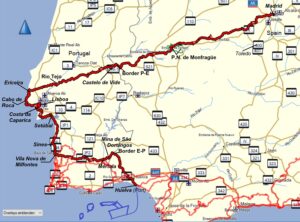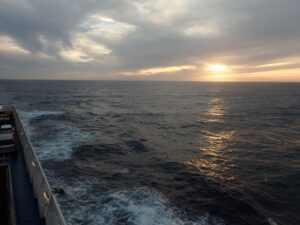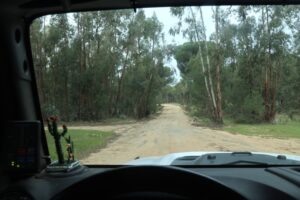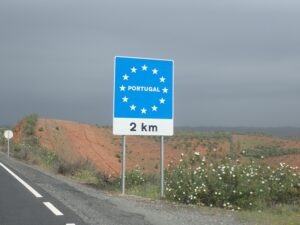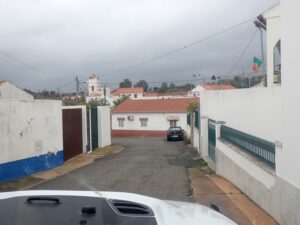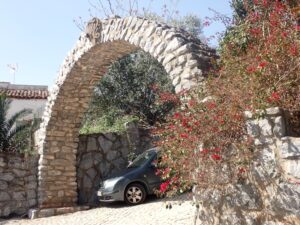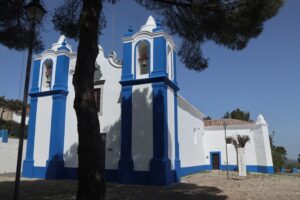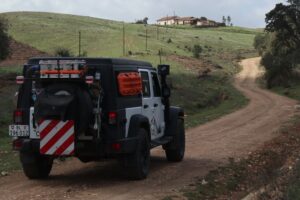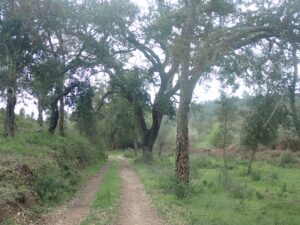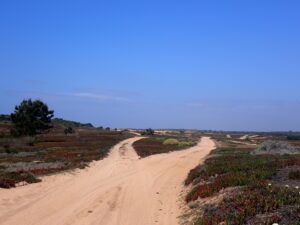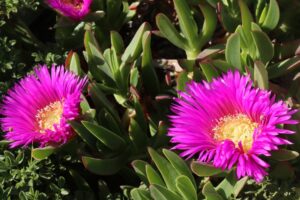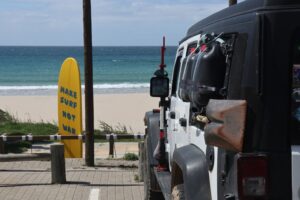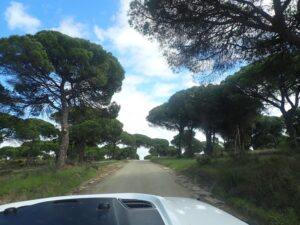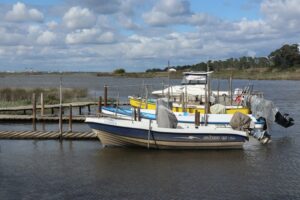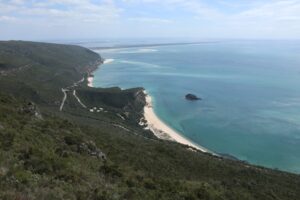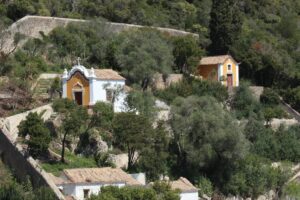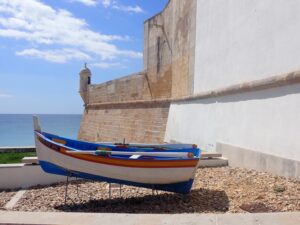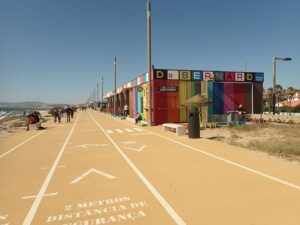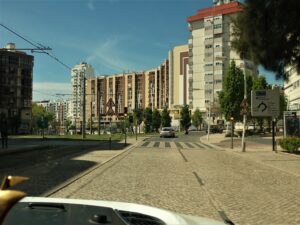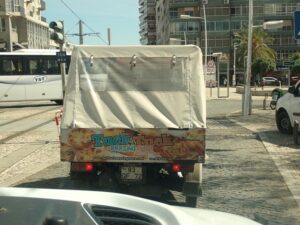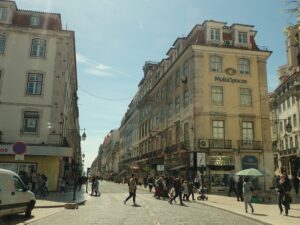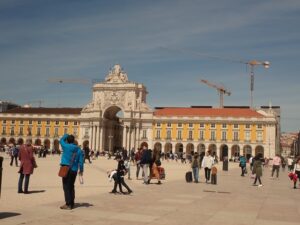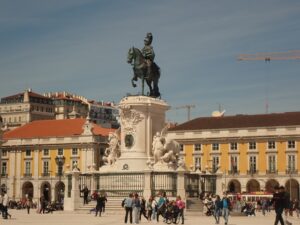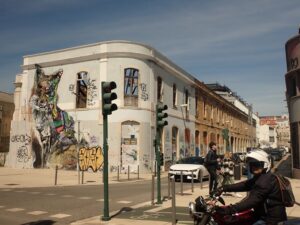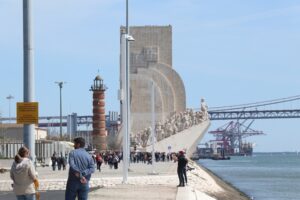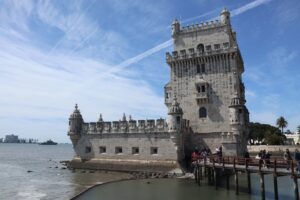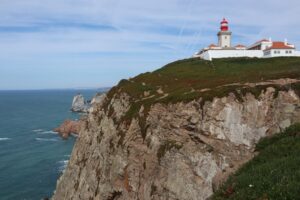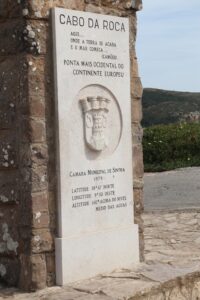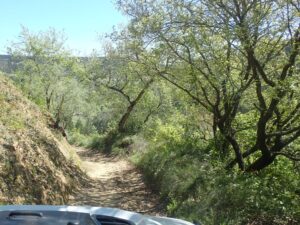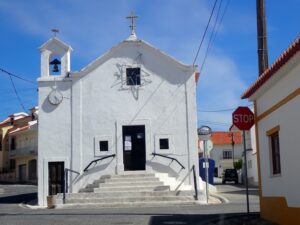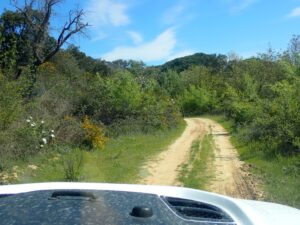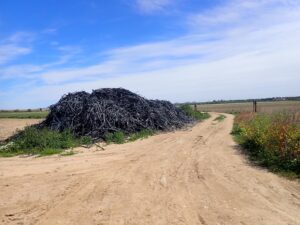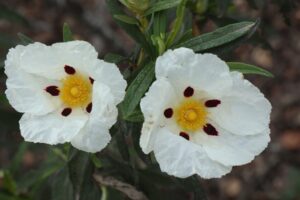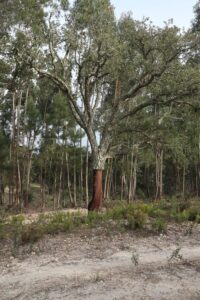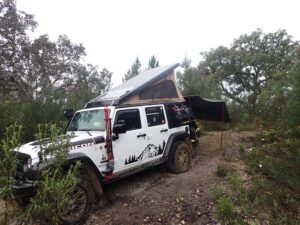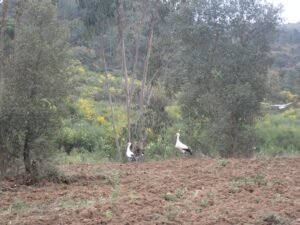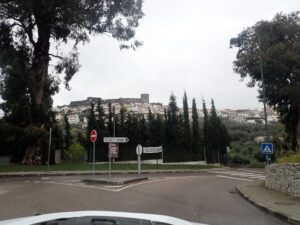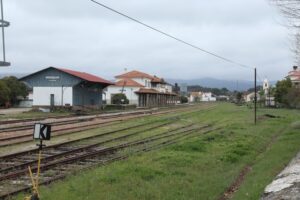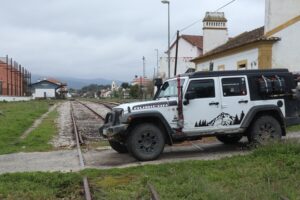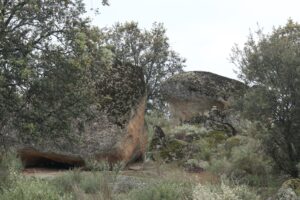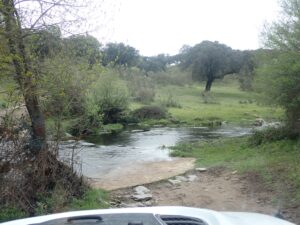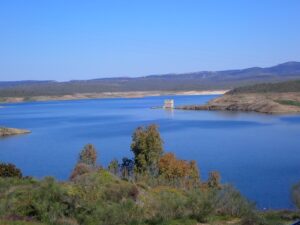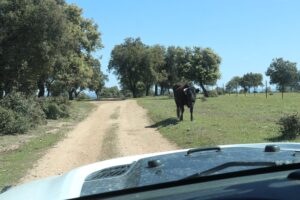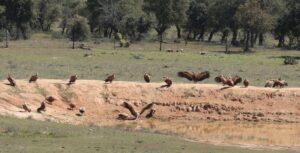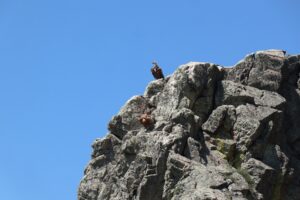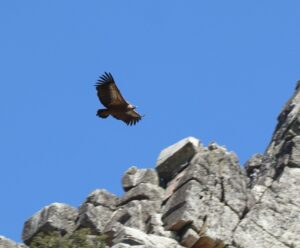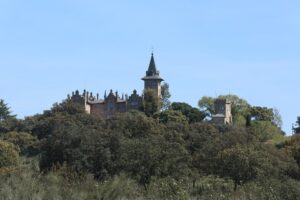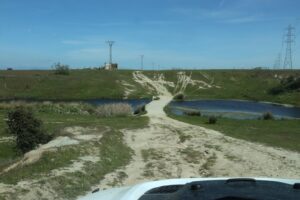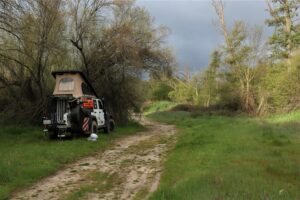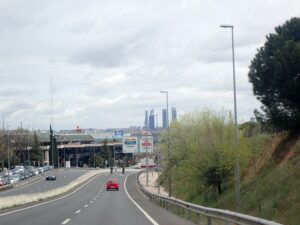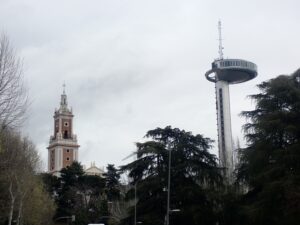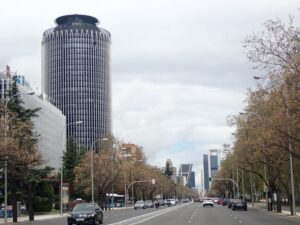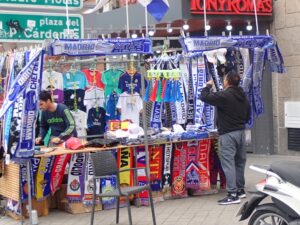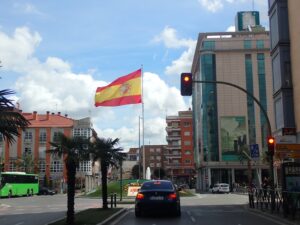>Translated with www.DeepL.com/Translator
(>Pictures at the bottom!)
….from Huelva via Portugal to Madrid
The April weather had already caught up with us when we docked at the ferry; the clouds hung low and a few raindrops slapped on the windscreen. Well, there would be no pleasant warmth and sunshine in southern Spain and Portugal. Although the weather forecasts predicted rather wet days, we ventured “cross-country” in the direction of Portugal.
Huelva was already behind us and we bumped through vast forests where pine trees were planted in rows, sneaked back onto the road through some fincas and thus made our way towards Portugal. The border crossing was hardly noticeable and only the big blue sign with the stars and the inscription Portugal made us aware that we had just crossed a national border. Neither a border control nor any indications regarding Covid-19; really nothing in this deserted area.
Our idea was to start our ride in Portugal where we forfeited in 2020. We drew a straight line across the map from that point and followed that line as closely as possible to the northwest. But instead of following this line, we had to take a diversion south of the “Parque Natural do Vale do Guadiana” for the time being. But in this almost deserted area, even the diversions was a lot of fun and we reached the ghost town of “Mina de São Domingos”, where ores were mined until the 1980s. The place and the mining company have a rather ambivalent reputation up to the present day, which is hardly noticeable in the current holiday settlement.
Since February 2021, there is a new law in Portugal that prohibits free standing outside designated places overnight. For us, it was a completely new starting point and, somewhat reluctantly, we sought out an appropriate spot each evening. But, in contrast to the past months in Spain and its islands, in Portugal there is an appropriate place in practically every larger town where you can set up camp for the night for a few euros.
After three days, we were finally back at the Atlantic Ocean, where we broke off our journey in 2020 because of the cold and Corona and returned home. Our direction of travel was immediately northwards and we were already following the west coast towards Lisbon. To our surprise; we were able to use the paths almost everywhere, which more or less followed the coastline and nowhere was there a prohibition sign nor were the paths blocked by barriers.
Before we reached the extensive river delta and the lagoon of the “Rio Sado”, our creeping journey through the dune landscape was over and we had to be satisfied with the tar belt. The ferry then took us over to the vibrant city of Setúbal late in the evening, where the locals were getting ready for a cosy evening in the many bars.
We didn’t want to get caught up in the Friday night rush hour in Lisbon, so we preferred to spend the night on the west coast among surfers. By the way, the whole west coast of Portugal must be a unique hotspot for the surfing scene, with people waiting for the ultimate wave at every conceivable corner and cove. Apart from the thrill of riding the waves, the surfers also contribute to the whole leisure industry accordingly. Business is done everywhere and the money seems to go over the counter easily.
On an early Saturday morning, we finally reached Lisbon. Unfortunately, we had to choose the motorway bridge over the “Rio Tejo”, as we did not find the place where a car ferry would cross, or this connection no longer exists. Despite everything, even without arriving by boat, cruising through this metropolis was another highlight of our return. Besides the many old buildings, some of the bold and modern architecture surprised us. The ocean liners moored at the quay also suggested a large mass of tourists in the city and everywhere there were endless people on the move on these warm days.
After Lisbon, the “Cabo Roca”, the westernmost point of the European mainland, could not be missing in our collection. But not only we, but whole columns of buses moved to this western point, which simply has to be visited. Despite the crowds of visitors, “being” at this point was something special; you can’t go any further west in Europe!
We then turned east at Ericeiria and again followed our straight line – on the map – to Madrid. Over a hilly landscape that conveys more mountains than it actually is and everywhere there was work in the vines. Presumably the Portuguese only drink wine! Later, we reached the vastness of the “Rio Tejo”, where farmers were tilling the fields with their machines in the huge fields. Grain and vegetable cultivation follows the wine cultivation in the plain. Here in this plain, everything is probably done for agriculture and even with the almost unaffordable petrol and diesel prices, it was worth filling up at the farmers’ cooperative; presumably the subsidised diesel was also available for us.
After the intensive farming, it became more mountainous again and more extensive family-owned farms followed, where cows, sheep and goats dominate the picture. In addition to the many farms, the hinterland of Portugal has countless historical treasures, and it always points to an eventful and successful past. The countless castles and fortresses still bear witness to these glorious times.
True to our motto – follow the line on the map – we crossed the border into Spain east of Castelo de Vide on a “forest and meadow crossing” and were amazed to find that a small river, a ford with dirt roads on both sides, separates the two countries. This time there wasn’t even a sign to alert us that we were now in Spain.
Shortly after crossing the border, we entered Spain’s youngest national park (P.N. de Montfragüe), which is home to many pairs of birds of prey such as black vultures, etc., as well as about 75% of all protected bird species. This area attracts many birdwatchers, and during our visit they were stalking in large numbers with their telescopes. The fact that, for example, the Covid 19 measures were still valid in Spain hardly interested these nature lovers and all local rules were thrown to the wind; presumably they only serve the locals.
After the Parque de Montfagüe, we discovered the “Cañada Real”, a vast network of former cattle drive corridors that date back to a royal law of the 13th century and are now an Eldorado for hikers and mountain bikers as well as off-roaders. For cattle drives, these paths are hardly used any more, but as public land, these 72-metre-wide corridors between the fincas are accessible to all and provided us with paths off the main routes. But it wasn’t always clear where the boundary was between public land and a finca, and already we were on the wrong side in the evening. We had already settled in and were enjoying the evening aperitif when a pick-up approached us from the bush. A bit unfriendly at first, but when the farmer realised that we were foreign tourists, we were granted a night on his finca. Finally, he asked us not to leave any rubbish, which is actually a matter of course, but in Spain……; well, Spain and its rubbish! One day the country will drown in rubbish. Even on the cattle drive corridor, where there is actually nothing to be found far and wide, there are beverage cans, PET bottles and all kinds of other rubbish in the landscape. What a pity!
The vast landscapes of “Extremadura” and “Castilla-La Mancha” were behind us when a sign announced the region of Madrid. No, there was still no sign of the urban agglomeration. But the increasing traffic – we were back on normal roads – announced somewhat more densely populated areas. The roads became directionally separated motorways and soon we could make out the first skyscrapers of Madrid in the far distance.
Whether it was coincidence or our planning; we reached Madrid on a Saturday afternoon and hoped for somewhat more pleasant traffic conditions in the Spanish metropolis. But for anxious drivers, even Saturday is rather challenging; presumably all Madrid residents have some rally training behind them and implement their driving style accordingly. We did not experience women in this way; it may be that the male sex is behind the wheel, or they were even more defensive on the road than we were 😉
Before we went to the campsite, which is located northeast of the centre, we visited the football stadium of the legendary club “Real Madrid”. Thanks to the upcoming match, there were already many attractions around the stadium and the flying traders with corresponding fan articles outdid each other with their offers. We also considered visiting the evening game, but the quiet evening at the campsite prevailed.
Over a glass of wine, we let the evening fade away and dreamed of our further crossing towards Andorra; along our straight line on the map, of course.
>Translated with www.DeepL.com/Translator

